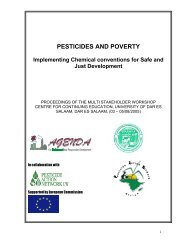Community Based Monitoring and the Chemical Conventions
Community Based Monitoring and the Chemical Conventions
Community Based Monitoring and the Chemical Conventions
You also want an ePaper? Increase the reach of your titles
YUMPU automatically turns print PDFs into web optimized ePapers that Google loves.
<strong>Community</strong> <strong>Based</strong> <strong>Monitoring</strong><br />
<strong>and</strong> <strong>the</strong> <strong>Chemical</strong> <strong>Conventions</strong><br />
www.pan-uk.org
<strong>Community</strong> monitoring is a locally-based process of<br />
documenting <strong>the</strong> effects of pesticides.<br />
Evidence of pesticide impacts can help governments to<br />
improve national pesticide regulation <strong>and</strong> help shape<br />
international instruments <strong>and</strong> policies for pesticide control.<br />
Through <strong>the</strong> process of documenting pesticide exposure<br />
<strong>and</strong> impacts, communities become more aware of <strong>the</strong><br />
risks, a first step toward adopting more ecological<br />
<strong>and</strong> sustainable agricultural practices <strong>and</strong> reducing<br />
<strong>the</strong>ir dependence on pesticides.<br />
3
Pesticide impacts on health <strong>and</strong> <strong>the</strong> environment<br />
Theextentofpesticidepoisoningisunknown:<strong>the</strong>WHOestimatedaround3<br />
millionayear(in1990),<strong>and</strong>estimatesofunder-reportingofpoisoning<br />
reach 98%.<br />
Systematicevidenceofnegativeimpactsshouldaffectpesticideregistrationdecisions.<br />
Inmanycountries,governmentsdonothave<strong>the</strong>resourcestoconductcomprehensive<br />
monitoring,particularlyinruralareaswhereincidentshappen.Thelackofaccuratedata<br />
makesitimpossibletoassess<strong>and</strong>manage<strong>the</strong>realrisksofpesticides.<br />
Thisreportpresentscommunitybasedmonitoringapproaches,<strong>and</strong>how<strong>the</strong>ywere<br />
adapted<strong>and</strong>usedinAfricain2005-2007,includingalinkwith<strong>the</strong>RotterdamConvention<strong>and</strong>its<br />
SeverelyHazardousPesticideFormulationprocedure.<br />
Thelegalbasisformonitoring<br />
“<br />
We had even a meeting with<br />
leaders from top level to village<br />
level <strong>and</strong> everybody was<br />
saying that was <strong>the</strong> first time<br />
people from <strong>the</strong> villages met with<br />
<strong>the</strong> bosses from <strong>the</strong> regional office<br />
<strong>and</strong> aired <strong>the</strong>ir views in<br />
”<br />
discussion with <strong>the</strong>m<br />
InternationalCodeofConducton<strong>the</strong>Distribution<strong>and</strong>UseofPesticides<br />
5.1.3 carryou<strong>the</strong>althsurveillanceprogrammesofthosewhoareoccupationally<br />
exposedtopesticides<strong>and</strong>investigate,aswellasdocument,poisoningcases:<br />
5.1.6 utilizeallpossiblemeansforcollectingreliabledata<strong>and</strong>maintainingstatisticson<br />
healthaspectsofpesticides<strong>and</strong>pesticidepoisoningincidents<br />
5.1.9 utilizeallpossiblemeansforcollectingreliabledata,maintainingstatisticson<br />
contamination<strong>and</strong>reportingspecificincidentsrelatedtopesticides<br />
RotterdamConventiononPriorInformedConsent(PIC)<br />
Article6:AnyPartythatisexperiencingproblemscausedbyaseverelyhazardouspesticideformulationunderconditionsofuseinitsterritory,mayproposeto<strong>the</strong>Secretariat<br />
<strong>the</strong>listingof<strong>the</strong>SHPFinAnnexIII.Theproposalshallcontainacleardescriptionofincidentsrelatedto<strong>the</strong>problem,including<strong>the</strong>adverseeffects<strong>and</strong><strong>the</strong>wayinwhich<strong>the</strong>formulationwasused.<br />
StockholmConventiononPersistentOrganicPollutants(POPS)<br />
Article11:<strong>the</strong>partiesshall..encourage<strong>and</strong>/orundertakeappropriateresearch,development,monitoring<strong>and</strong>cooperationpertainingtoPOPs,includingon<strong>the</strong>ireffectson<br />
humanhealth<strong>and</strong><strong>the</strong>environment;socio-economic<strong>and</strong>culturalimpacts<br />
4
<strong>Community</strong>-based monitoring<br />
Pesticidehealth<strong>and</strong>environmentalproblemsariseduetoinformationgaps<br />
on<br />
actualimpacts<strong>and</strong>poorpracticesby<br />
farmers,whodonotorcannotapply<br />
labelsafetyprecautions.Bo<strong>the</strong>lements<br />
needtobeaddressedtoreduce<strong>the</strong>devastatinghealth<strong>and</strong>environmentalcosts<br />
ofpesticideuse.<br />
Environmentaldamagehasnegativeimpactson<br />
eco-system‘services’thatcommunitiesrelyon,<br />
suchascleanwater,fertilesoils,<strong>and</strong>pollinators<br />
<strong>and</strong>o<strong>the</strong>rbeneficialinsectsthatprovidepest<br />
control.Poisoning<strong>the</strong>environmentaffects<strong>the</strong><br />
poorestpeoples’livelihoodsdisproportionately.<br />
Hospitalisedpoisoningcasesofteninvolvesuicideattemptsorseriousaccidents.‘Mild’workrelatedcasesarenotreported,orif<strong>the</strong>yare,<br />
healthpractitionersmaynotrecognise<strong>and</strong>h<strong>and</strong>le<strong>the</strong>mbecausesigns<strong>and</strong>symptoms<br />
aresimilartoo<strong>the</strong>rhealthproblems.Longtermpesticidepoisoninghasun-quantified<br />
costsonlostproductivity<strong>and</strong><strong>the</strong>abilitytosupportfamilies.<br />
Pesticidelabelssetoutbasicmeasurestobeadoptedwhenusing<strong>the</strong>product.However<br />
personalprotectiveequipment(PPE)isnotavailableoraffordabletomanyfarmers,<br />
<strong>the</strong>rearefewcollectionsystemstoallowsounddisposalofcontainers,<strong>and</strong>labelprecautionsregardingspraying<strong>and</strong>mixingoftencan’tbeaccessedorreadbyworkers.Alack<br />
ofunderst<strong>and</strong>ingof<strong>the</strong>risksofpesticideuse,tohealth<strong>and</strong>particularlyto<strong>the</strong>environment,leadstorisky<strong>and</strong>‘off-label’behaviour.<br />
Farmers,oftenilliterate,havenosource<br />
ofinformationexceptpesticidedealers.<br />
Involving<strong>the</strong>mcloselyinregularmonitoringofhealth<strong>and</strong>environmentalimpactscanhelpplantationworkers<strong>and</strong><br />
farmingcommunitiesrealise<strong>the</strong>yare<br />
beingpoisoned.Adeeperunderst<strong>and</strong>ing<br />
of<strong>the</strong>risksofpesticideusemaydrivebehaviouralchangestopreventincidents<br />
fromhappening. Theprocessofmonitoringalsoincreases<strong>the</strong>levelofscientific<br />
<strong>and</strong>technicalcompetenceat<strong>the</strong>local<br />
level<strong>and</strong>helpscommunitiestakecharge<br />
toaddresscommunity<br />
exposure.<br />
5
<strong>Community</strong>PesticideAction<strong>Monitoring</strong><br />
(CPAM) wasdevelopedbyPANAsia<strong>and</strong><strong>the</strong>Pacificin<strong>the</strong>1990’stodocument<strong>and</strong>createawarenessofpesticideimpacts.CPAMisdonewith<br />
informed<strong>and</strong>consentingcommunities(especiallywomen<strong>and</strong>underrepresentedgroups),<br />
basedonParticipatoryActionResearch, <strong>and</strong>encouragingorganising<strong>and</strong>actionamong<strong>the</strong><br />
communitymembers.Externalpartnersareaccountableforprovidinglegalormedicalsupport<br />
<strong>and</strong>sharingalternatives(suchasbiodiversitybasedecologicalagriculture<strong>and</strong>IPM)ifneeded.<br />
CPAMwasusedbyMalaysianplantationworkers<br />
toidentifyparaquatasamajorproblem,<strong>and</strong><br />
takeactiontopreventfur<strong>the</strong>rexposure.CommunitiesinKasargodDistrict,Kerala(India)successfullyusedCPAMtoidentifyhealth<strong>and</strong><br />
environmentalimpactsofendosulfan<strong>and</strong><br />
achievedastateban.<br />
<strong>Monitoring</strong>questionnairescanbecompletedby<br />
‘outsiders’ duringinterviews(alwaysinconsultationwith<strong>the</strong>communityhowever);<br />
orby<br />
communities<strong>the</strong>mselvesinawrittenquestionnaireorsimpleillustratedself-surveillancecards<br />
<strong>the</strong>ydesign<strong>the</strong>mselves,e.g.onpesticideuse<br />
<strong>and</strong>specifichealthsymptoms.Bloodtesting<br />
<strong>and</strong>medicalinvestigationcancomplementinitialdocumentation<strong>and</strong>recordingofsymptoms.<br />
Someof<strong>the</strong>mostimportantenvironmentalincidents<br />
causedbypesticideswillbeeasilynoticeable–frog,toad,snakeorbirddeaths,<br />
widespreadfishorbeekills,plantdamage–<strong>and</strong><br />
anyonein<strong>the</strong>communitycanbeempoweredto<br />
record<strong>and</strong>report<strong>the</strong>m.Moredetailedfield<br />
monitoringofecologicalimpactscanassess<br />
populationstatusoffauna<strong>and</strong>ecological<br />
processes,<strong>and</strong>mayestablishacause<strong>and</strong>effect<br />
relationship.<br />
Thepublication‘Ecological<strong>Monitoring</strong>Methods’providesacomprehensiverangeof<br />
fieldmethodologiessuitableforusein<strong>the</strong>tropics.Itwaswrittenspecificallyforpeople<br />
withsomescientifictraining<strong>and</strong>fieldexperience;howeveranumberof<strong>the</strong>methodologiesaresimple<strong>and</strong>couldbeusedbynon-scientists.Analysis<strong>and</strong>interpretationofresultsdoesrequireascientificbackground.<br />
Themanual<strong>and</strong>h<strong>and</strong>booksarenowavailable<br />
inEnglish<strong>and</strong>French<strong>and</strong>onlineat<strong>the</strong>UniversityofGreenwichwebsite.<br />
6
Findings: <strong>Monitoring</strong> training <strong>and</strong> studies in Africa<br />
PANpartnersinAfrica,Asia<strong>and</strong><strong>the</strong>Pacific,<strong>and</strong><strong>the</strong>UKbuiltcapacityfor<br />
pesticideimpactmonitoringinAfricathrough<strong>the</strong>project‘Pesticides&<br />
Poverty’from2005-2008.Atcommunitylevel,<strong>the</strong>Asianmodelofcommunitybasedpesticidemonitoring(CPAM)wasadapted<strong>and</strong>disseminated.<br />
Throughcollaborationwith<strong>the</strong>RotterdamConventionSecretariat,<strong>the</strong><br />
community-basedapproachwaslinkedto<strong>the</strong>governmentreportingofseverelyhazardouspesticideformulationsforinternationalconventions.Finally,scientistsfromacademic,government<strong>and</strong>non-government<br />
institutionsweretrained<strong>and</strong>practiced ecologicalmonitoring.<br />
TheAsianCPAMmoduleswereupdatedwithAfricancasestudies,re-illustrated<strong>and</strong>translatedintoFrench,<br />
<strong>and</strong>usedtotrain72NGO<strong>and</strong>governmentrepresentativesin<strong>the</strong><br />
methodology.NGOsinfivecommunitiescarriedou<strong>the</strong>althmonitoring<br />
studies,includingtwolinkingup<br />
communitymonitoringwith<strong>the</strong>RotterdamConventionDesignatedNationalAuthorities(DNA).<br />
Theecologicalmonitoringh<strong>and</strong>bookwastranslated<strong>and</strong>usedtotrain64peoplefrom8<br />
countries.Thetrainingcovered<strong>the</strong>RotterdamConventionEnvironmentalIncidentReportForm(EIRF),<strong>and</strong>includedlab<strong>and</strong>fieldwork.Pre-<strong>and</strong>post-trainingtechnicaltest<br />
scoresinpracticalecologicalmonitoringmethods<strong>and</strong>conventionsshowa22.5%averageimprovement,whilephysicalcapacitywasalsoimprovedthroughprovisionofbasic<br />
field<strong>and</strong>labequipment.<br />
Threeeco-toxmini-projectswereconductedin<br />
Ethiopia,Mali<strong>and</strong>Tanzaniaincluding:<br />
•Survey offarmersonpesticideuse<strong>and</strong>conditions.<br />
•Rapidriskassessmentbasedon<strong>the</strong>surveyresults.<br />
•<strong>Community</strong>meetingstoreportonresults,<strong>and</strong>provide<br />
fur<strong>the</strong>rinformation.<br />
7
“<br />
Wehadtrainedonly25<strong>and</strong>wetold<strong>the</strong>mtogoout<strong>and</strong>disseminate<strong>the</strong>newinformation.Untiltoday<strong>the</strong>yarephoningus:<br />
“Whenareyoupeoplecomingback?Wehavecollectedalotofinformation<strong>and</strong>weneedyoutocomeback”because<strong>the</strong>firsttime<strong>the</strong>ycollectedwewentback<strong>and</strong>analysed<strong>the</strong>datawith<strong>the</strong>mshowed<strong>the</strong>m<br />
howtofindsolutionsfromwithin.But<strong>the</strong>yhaveregularvillagemeetings<strong>and</strong><strong>the</strong>yhaveforced<strong>the</strong>villagemanagementauthoritiestogive<br />
<strong>the</strong>monehourineveryvillagemeetingtodisseminate<strong>the</strong>information<br />
aboutpesticides.So<strong>the</strong>yreceivedityouknow.Wedidn’texpect<strong>the</strong>impacttobesuch....<strong>and</strong>thiswasjustapilot.<br />
”<br />
Thecombinedresultsof<strong>the</strong>health<strong>and</strong>eco-toxmonitoringstudiesarepresentedhere.<br />
ConditionsofUse<br />
Ourmonitoringprovidesevidenceof<strong>the</strong>widegapbetweenlabelinstructions<strong>and</strong><strong>the</strong><br />
realityofpesticideusein<strong>the</strong>surveyedcommunities.<br />
Pesticideimpacts<br />
DDTisillegallyusedinEthiopiabyalmost30%ofsurveyedfarmers.Therapidriskassessmentsidentifiedthisasparticularlyconcerning,<strong>and</strong>ajointworkshopwasorganised<br />
withNGOs<strong>and</strong>government,onhowtoaddressthisissue.<br />
8
Frequency of health effects<br />
% of farmers<br />
(Ngerananyuki study, Tanzania)<br />
Farmers affected by pesticides in last farming season 69<br />
Number of incidents in last farming season:<br />
One<br />
9<br />
Two<br />
10<br />
Three<br />
8<br />
More than three incidents<br />
22<br />
Pesticide involved:<br />
Incident involving Fenon C<br />
Incident involving Selecron<br />
Action taken:<br />
Drank milk<br />
Went to <strong>the</strong> hospital<br />
Washed with water<br />
No action taken<br />
Admission to hospital:<br />
Once<br />
Twice<br />
Three times<br />
More than three times<br />
27<br />
21<br />
43<br />
28<br />
2<br />
3<br />
17<br />
19<br />
7<br />
58<br />
9
Healthriskswerealsoidentifiedfor2,4-D<strong>and</strong>malathioninEthiopia<strong>and</strong>SelecroninTanzania.Thesurveyoffarmers’healthincidentsinTanzaniaconfirmedthis,withover20%<br />
offarmersattributedahealthincidenttoSelecron.Thisdemonstrates<strong>the</strong>interplayof<br />
health<strong>and</strong>ecologicalmonitoring.<br />
41%offarmersnotedadecreasein<strong>the</strong>numbersofbeneficialinsects.Aswellas demonstrating<strong>the</strong>non-discriminate<strong>and</strong>unintendedconsequencesofpesticideuse,<strong>the</strong>surveysshowhowfarmerscancontributetocommunity-basedecologicalmonitoring.<br />
SelfsurveillanceofTanzanianfarmersoverathreemonthperiodshows<strong>the</strong>frequency<br />
<strong>and</strong>extentofpesticidepoisoningsymptoms.<br />
Usingappropriatelanguage<br />
Surveysmustbeinlocallanguages,<strong>and</strong>bepretestedincludingbothlanguage<strong>and</strong>culturalaspectstoavoidconfusion.Alocallanguage<br />
questionnairewasdevelopedinSikasso,Mali,<strong>and</strong><br />
<strong>the</strong>PICsurveyformwastranslatedintoKiswahili<br />
by<strong>the</strong>projectinTanzania.Revisedversionsof<strong>the</strong><br />
PICsurveyformweredevelopedinTogo<strong>and</strong>Tanzaniatomake<strong>the</strong>measiertousebycommunities.<br />
InBenin,communitymonitoringofpesticidepoisoninginvolvedtraininguniversitystudentsto<br />
conductfieldworkin<strong>the</strong>irownregions,using<strong>the</strong>ir<br />
ownlanguage.<br />
10
“<br />
TheMinistryisveryinterested<br />
<strong>and</strong>hasstartedprovidingsome<br />
smallmoneytoundertakethisactivity–initiationofcommunity-based<br />
monitoringto<strong>the</strong>“hotspots”areas<br />
wherewethink<strong>the</strong>problemis–so<br />
thisisgoingtobesustainable.<br />
”<br />
Embedding<strong>the</strong>commitmenttomonitor<strong>and</strong>report<br />
Whileashorttermprojectmayequipcommunitiestoreportincidentsofpoisoning,or<br />
o<strong>the</strong>rpesticideimpacts,along-termcommitmenttoreportingincidentsin<strong>the</strong>future<br />
shouldalsobeestablished.<br />
InSikasso,acontractsignedwith<strong>the</strong>localradiostationKenedougouprovidedforradio<br />
showsonpesticideissuesfor3monthsfollowing<strong>the</strong>projectdate.Oneof<strong>the</strong>radiopresentersattended<strong>the</strong>training,<strong>and</strong>respondedtonumerousphonecallsfrom<strong>the</strong>public<br />
following<strong>the</strong>show.Theradioindependentlyorganisedaroundtablewithlocalmayors<br />
<strong>and</strong>NGOs,following<strong>the</strong>popularityof<strong>the</strong>shows.<br />
AreportingchannelforpesticideincidentsfromgrassrootstoPICDNAwasdefined<strong>and</strong><br />
proposedinTanzania,<strong>and</strong>communitymonitoringteamsestablishedin7villages<strong>and</strong><br />
proceduresagreedtoimplementasuccessfulreportingchaininTanzan<br />
Tanzaniahasallocatedanewbudgetlineforcommunitymonitoringin<strong>the</strong>Ministryof<br />
AgricultureRotterdamConventionimplementationworkplan.<br />
InEthiopia,422surveyswereconductedby50highschoolstudentsfromenvironment<br />
clubsin<strong>the</strong>RiftValley,aftertrainingbasedonamodulepreparedwith<strong>the</strong>cropprotectiondepartmentin<strong>the</strong>MinistryofAgriculture&RuralDevelopment<br />
11
Networkingbetweensectors<br />
NetworkingbetweenNGOs<strong>and</strong>governmentbodieswasenhanced,withbenefitsfor<br />
traineesin<strong>the</strong>irwork:<br />
•AddisAbbaUniversityisnowsharingpesticideresidueanalyticalequipmentwith<strong>the</strong><br />
EthiopianQuality<strong>and</strong>St<strong>and</strong>ardsAuthority<br />
•TheDivisionRegionaledel’EnvironnementetdesEtablissementsClasseesinMatam,<br />
Senegalisusingecologicalmonitoringinalocustcampaign<br />
•AjointmeetingofNGOs<strong>and</strong>governmentpublicised<strong>and</strong>discussed<strong>the</strong>findingsof<strong>the</strong><br />
studyrelatingtoillegaluseofDDTinEthiopia<br />
•NGOsin<strong>the</strong>eco-toxnetworkinEthiopiacommentedon<strong>the</strong>listofpesticides<br />
forregistration<br />
<strong>Community</strong>monitoring<strong>and</strong>behaviourorpolicychanges<br />
ThefirstAfricancountrytobanendosulfanisonewhereanNGOinitiativehasbeenactivesince2000indocumentingpesticideimpacts.TheresultsinBeninconsistentlyimplicatedendosulfanforalargeproportionofdeaths,<strong>and</strong>thisinformationwasusedby<br />
<strong>the</strong>governmenttosupportitsbanonendosulfanin2008.<br />
“<br />
Inonecase,dursbanwassprayedtocattletocontrolticks<br />
<strong>and</strong>thoseanimalsdied<strong>and</strong>wereconsumed.Peoplewho<br />
ate<strong>the</strong>meatwerepoisoned,as<strong>the</strong>ydevelopedsymptoms<br />
suchasstomachproblems(diarrhoea).<br />
Inano<strong>the</strong>rincidentcattlediedafterdrinkingwaterin<strong>the</strong><br />
irrigationcanalwheresprayingequipmentwererinsed<br />
”<br />
Ngerananyuki,SouthAfrica<br />
FarmersinNgarenanyukihavestoppeddisposingofpesticidesinasitein<strong>the</strong>village<br />
market,<strong>and</strong>usingUltraLowVolume(ULV)formulationsinwaterspray<br />
Publicoutreach<strong>and</strong>valueformoney<br />
Themini-projectsalldemonstrate<strong>the</strong>valueformoneyofadoptingcommunitybased<br />
approaches,byreachinglargenumbersofdirectbeneficiarieswithbudgetsofonly<br />
around$10,000.Thehealthmonitoringprojectsreachedover900peopleinBenin,Mali,<br />
Tanzania<strong>and</strong>Togo,while913farmersweresurveyedinEthiopia<strong>and</strong>Tanzaniaduring<br />
<strong>the</strong>eco-toxprojects.Over400additionalpeopleattendedcommunitymeetings<strong>and</strong>in<br />
Maliadebatebetweengovernmentrepresentativeswasbroadcastin2locallanguages<br />
toupto1.5millionpeopleinMopti.<br />
12
Starting community monitoring<br />
Whe<strong>the</strong>rthroughacommunity-ledproject,oramoretechnicalsurveyofpesticideimpacts,moreinformationisessentialregarding<strong>the</strong>impactsofpesticidesas<strong>the</strong>yarecurrentlyusedinmanydevelopingcountries.<br />
‘<strong>Community</strong>PesticideActionKits’(CPAK)helpcommunitiestostartmonitoring,based<br />
onaseriesof‘modules’withreferencematerial<strong>and</strong>guidancefortrainers.A‘methodologymodule’providesanintroductionto<strong>the</strong>approachasithasbeenusedinAsia<strong>and</strong><br />
<strong>the</strong>Pacific.Fur<strong>the</strong>rmodulescoverhealth,environmental,labour,legislation<strong>and</strong>corporateaspectsofpesticides.Allmodulesarebasedoncasestudies,<strong>and</strong>arecompletelyillustratedforusebycommunities.Theyshouldbecomplementedbylocalsupports,<br />
includingvideo,games,posters,puppets,radio,etc.<br />
Thefirststepistoidentifyacommunitywhowanttostartmonitoring.Closeinvolvementof<strong>the</strong>communityatallstagesofplanningisanessentialfeatureofCPAM.Training<br />
offacilitators,ei<strong>the</strong>rwithin<strong>the</strong>communityorinorganisationsthatworkwith<strong>the</strong>m(e.g.<br />
farmergroups,women’sgroups),canhelpbuild<strong>the</strong>irowncapacity<strong>and</strong>help<strong>the</strong>mlead<br />
o<strong>the</strong>rs.Localexamples,trainingaids,<strong>and</strong>peoplecanbeidentifiedtohelpmake<strong>the</strong><br />
monitoringmoreeffective.<br />
Thefirststepistoidentifya<br />
communitywhowantto<br />
startmonitoring...<br />
Themonitoringstageincludesdevelopmentofamonitoringtool,including<br />
testing,<strong>and</strong>aperiodofcollectingdata.<br />
ThePANH<strong>and</strong>bookprovidesanumber<br />
ofpossiblereportingtemplatesorquestionsthatcanbeadapted.<br />
Finally,feedbackcanincludepublicmeetingstoshareresults,<strong>and</strong>discusswhat<strong>the</strong>communityc<strong>and</strong>onexttoreduce<strong>the</strong>irexposure<strong>and</strong>preventharm.Oneoptionistouse<strong>the</strong><br />
resultsforadvocacy,whichcouldincludelobbyingforanationalbanorreportingincidentsto<strong>the</strong>Rotterdamconvention.<br />
Ecologicalmonitoringcanbeincludedwithinacommunity-basedapproach,asobserving<strong>and</strong>reportingenvironmentalincidentscanbedonebyanyone.Alocalperson<br />
shouldbedesignatedtoreceivereports<strong>and</strong>pass<strong>the</strong>montoofficialstructuresforfur<strong>the</strong>rinvestigation.<br />
Fieldmonitoringrequirestrainedpeoplewi<strong>the</strong>xperienceofscientificsamplingofflora<br />
<strong>and</strong>/orfauna–fromalocalinstitution,orfromcentralgovernment(PICDNA/POPsfocal<br />
point)–<strong>and</strong>equipmentforfieldmonitoring<strong>and</strong>sampleprocessing<strong>and</strong>counting.<br />
13
Conclusions<br />
Thereactionof<strong>the</strong>highschoolstudentson<strong>the</strong>impactofpesticides<br />
waspuzzling.Ithought<strong>the</strong>ywouldknowof<strong>the</strong>problemsofpesticidesfrom<strong>the</strong>irexperience....<strong>the</strong>seyoungpeoplearereallyinterested<br />
inenvironmentalissues<strong>and</strong><strong>the</strong>yhavenowbecomepioneers<br />
Theextentof<strong>the</strong>lackofawarenessof<strong>the</strong>chemicalconventionsisenormous.Awareness-raising<strong>and</strong>capacitybuildinginrelationtopesticidehazards<strong>and</strong>regulatoryframeworksarerequiredatalllevels.<br />
InTanzania,notasinglefarmer,veryfewvillageleaders<strong>and</strong>aminorityofagricultural<br />
extensionworkersareawareofanyof<strong>the</strong>internationalchemicalconventionssigned<br />
<strong>and</strong>ratifiedby<strong>the</strong>ircountry<br />
Evenecotoxtraineeswerenotfamiliarwith<strong>the</strong>detailsofall<strong>the</strong>conventions,despite<br />
beingselectedon<strong>the</strong>basisof<strong>the</strong>irexpertise<strong>and</strong>knowledge<br />
Actualconditionsofuseofpesticidesbyruralcommunitiesdiffermarkedlyfrom<strong>the</strong><br />
labelconditions.Labelconditionsare<strong>the</strong>basisforregistrationofpesticides<strong>and</strong>provide<br />
awaytopreven<strong>the</strong>alth<strong>and</strong>environmentalproblems–pesticidesshouldonlyberegisteredwhen<strong>the</strong>regulatorsareconfidentthatlabelconditionsarerealisticallylikelytobe<br />
respectedby<strong>the</strong>averageuserof<strong>the</strong>pesticide.<br />
Whileonlycertainincidentscanbenotifiedto<strong>the</strong>Rotterdamconventionfor‘severely<br />
hazardouspesticideformulations’,itisworthdocumenting<strong>and</strong>reportingallincidents,<br />
assharingnationalchangesinpolicy<strong>and</strong>fieldevidenceisanequallyimportantelement<br />
of<strong>the</strong>Convention.<br />
<strong>Community</strong>basedmonitoringrequiresrelativelysmallfinancialresourcestostartdocumenting<strong>and</strong>actingonpesticideimpacts.Theresultsreportedinthispublicationindicatethatpesticidesarecausingreal,ongoingdamagebothtohumanhealth<strong>and</strong><strong>the</strong><br />
environment.<br />
Governmentsareultimatelyresponsiblefor<br />
ensuring<strong>the</strong>health<strong>and</strong>safetyof<strong>the</strong>ircitizens.Theinternationalconventionsareintendedtoprotectworkerhealth<strong>and</strong><strong>the</strong><br />
environment.Thelongestjourneystartswith<br />
asinglestep–soevenif<strong>the</strong>reisalackofresources<strong>and</strong>capacitytoactonpesticides,<br />
communitymonitoringisavaluable<strong>and</strong>realisticfirststeptowardbetterpesticideregulation.Althoughthisprojecthasincreased<br />
awarenessaboutconventions,<strong>and</strong>ga<strong>the</strong>red<br />
dataamongtrainees<strong>and</strong>ruralcommunities<br />
involved,muchworkremainstobedone.<br />
14
The future<br />
PANUK isworkingtopromote<strong>and</strong>encouragecommunitybasedmonitoring,<strong>and</strong>toincreaseawareness<strong>and</strong>actionon<strong>the</strong>internationalconventions.Ourprioritiesfor<strong>the</strong><br />
comingyears include:<br />
•CollaborationamongallPANgroupsworkingwithcommunities,<strong>and</strong>common<br />
reportingofmonitoringresults,through<strong>the</strong>PANInternationalnetwork.<br />
•Using<strong>the</strong>resultstodemonstrate<strong>the</strong>trueimpactsofpesticideusebysmallfarmers<br />
<strong>and</strong>plantationworkers;<strong>and</strong>generatemedia<strong>and</strong>politicalattentionforactionon<strong>the</strong><br />
worstpoisons.<br />
•Integratingcommunitybasedmonitoringwithglobalconventions,e.g.bytranslating<br />
PICseverelyhazardousreportformsintolocallanguages,<strong>and</strong>establishing<br />
collaborationsogovernmentsusedataas<strong>the</strong>basisfor<strong>the</strong>irnotifications.<br />
•Advocatingonenvironmentalimpacts:Fur<strong>the</strong>reco-toxtraining<strong>and</strong>supportforfield<br />
worktoconductregularmonitoringofpesticideecotoxicology:<strong>and</strong>morepractice<strong>and</strong><br />
widening<strong>the</strong>numberofpeopleabletocarryoutRRAs;<strong>and</strong>developingmaterialsto<br />
enableruralcommunitiesinAfricatorecordenvironmentalincidentobservations<br />
•RealisationofTanzanianreportingchannel<strong>and</strong>establishmentofo<strong>the</strong>rs.<br />
15
Fur<strong>the</strong>r Information<br />
Ecologicalmonitoringmethodsfor<strong>the</strong>assessmentofpesticideimpactsin<strong>the</strong>tropics.H<strong>and</strong>book<strong>and</strong>Methodssheets.Grant,<br />
I.F.&Tingle,C.C.D(eds.)2002.CTA,The<br />
Ne<strong>the</strong>rl<strong>and</strong>s,English+French<br />
EnvironmentalIncidentReportFormfor<br />
<strong>the</strong>RotterdamConvention(PICEIRF)<br />
AnAssessmentof<strong>the</strong>PesticideUse,Practice<strong>and</strong>Hazardsin<strong>the</strong>EthiopianRiftValley,<br />
TadesseAmera<strong>and</strong>AsferachewAbate,<br />
Feb2008<br />
<strong>Community</strong>pesticidessurvey<strong>and</strong>awarenessraisinginMbeyaregion,Tanzania:October–December2007,Mbogho,A.Y,<br />
January2008<br />
Projetd’Informationetdesensibilisation<br />
surleseffetsenvironnementauxdespesticidesdanslescommunesdeMopti,SocouraetSio,RégiondeMopti,ODI-Sahel,<br />
Mars2008<br />
CPAMmodules(African<strong>and</strong>Asianversions),Casestudyon<strong>the</strong>preparationof<br />
<strong>the</strong>healthmonitoring(PANUK,forFAO)<br />
RapportFinalNarratifDuProjet<strong>Monitoring</strong>CommunautairePesticidesAuTogo,<br />
AllianceNationaledesConsommateurset<br />
del’Environnement.<br />
FinalReportOnStrategiesFor<strong>Community</strong><br />
<strong>Monitoring</strong>OfSeverelyHazardousPesticidesFormulations<br />
(CREFTNov07)<br />
<strong>Community</strong>Pesticides<strong>Monitoring</strong>In<br />
Ngarenanyuki,FinalImplementationReport,WAHSA:ActiononPesticides,Tropical<br />
PesticidesResearchInstitute(TPRI)<br />
Projetde<strong>Monitoring</strong>communautairede<br />
Sikasso,Mars–2007<br />
Reducing<strong>the</strong>impactofpesticidesthrough<br />
communitypesticidemonitoringWAHSA,<br />
2008<br />
www.pan-uk.org<br />
PesticideActionNetworkUK<br />
DevelopmentHouse,<br />
56-64LeonardStreet,<br />
London,EC2A4LT<br />
admin@pan-uk.org<br />
+44(0)2070650905
















